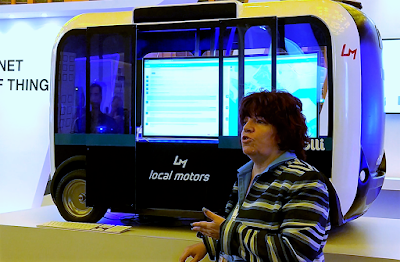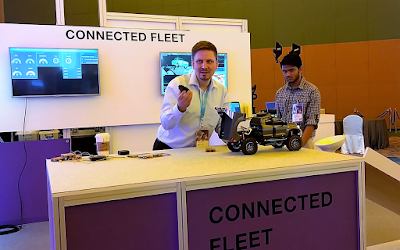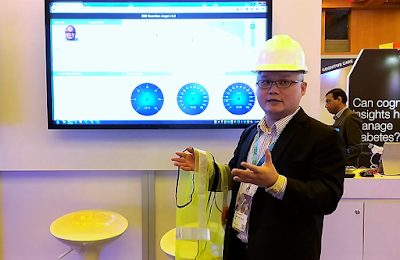We were at IBM’s Connect2017 event last month to find out more about the possibilities of cognitive solutions in the area of Internet of Things. IoT is all about sensors,data and connectivity. AI can make sense of these data and take the next step to produce key insights and recommendations. In the connected future with IoT + AI, what type of applications and solutions can we expect?
Connected Mobility
- Olli is a connected self-driving electric vehicle designed to work as part of a fleet management system with a central operation center to solve the needs of large campuses and municipalities. With the Olli mobile application, commuters can find existing routes and charter an Olli vehicle for their transport needs. It’s like an autonomous taxi service for the future.
- Local Motors have shown us ways where artificial intelligence can be put into such an application. The Olli vehicle can interact with the commuters with natural language. Commuters can simply speak in their native language, and Olli can respond effectively with the right information. For example, one can ask Olli for the nearest highly rated restaurant, and Olli can do a recommendation and bring you there automatically.
Connected Fleet
In today’s context, fleet management services are largely limited to data management processes. For example, these systems only store information about each vehicle, such as its last serviced date and last recorded mileage.
More advanced systems also include GPS sensors on the vehicles to track their movements. This is the first step for fleet management services to move into the IoT space. With different IoT sensors that are available, much more data can be captured on individual vehicle for different purposes. The captured data can then be aggregated and analyzed by artificial intelligence for coming out with useful information. Here are some possibilities that were showcased.
- With various sensors on the vehicle, the key health of the vehicle can be determined on the fly. This information can be gathered and used to propose maintenance schedules, reducing the risks of vehicles breaking down.
- The acceleration patterns and habits from the drivers can be captured from the sensors on the vehicle. This can help to recommend preferred driving patterns for better fuel economy for cost savings.
- With the use of camera as a sensor on the vehicle, video footage can be streamed directly to remote servers for further analysis. This opens up the possibilities of updating potential road hazards captured from the camera to other drivers on the same road.
- With all the different data available, better decisions can be made for route planning. Each vehicle’s details can be useful insight to other vehicles from the same fleet.
Connected Consumer
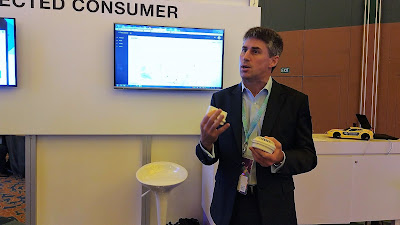 |
| IBM Executive showing off some of the sensors available for consumer applications |
IoT be can used in many different consumer applications. These applications can be built to serve the consumers for them to make better decisions. In the near future, we do expect new product and services that are built upon consumer solutions in the space of IoT.
IBM showcased two specific applications of consumer applications that are possible with IoT and data analytics on Watson.
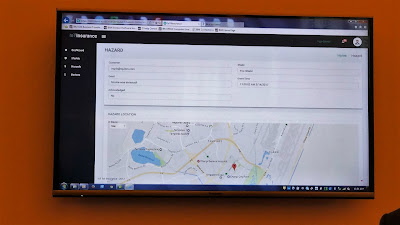 |
| Insurance Claim Portal with IoT Data |
- Insurance – By integrating different kinds of sensors in your house, insurance companies will have the ability to expedite claim process. For example, with fire detection sensors / heat sensors that are placed in the house, an alert can be sent to the insurer and the emergency department when a fire occurs. The fire insurance claim application process can then be kick-started without any actions by the insurer. Data from the sensors in the house will help the insurance company to determine the claim amount and render any kind of help to the insurer.
This new method of insurance claim allows insurance companies to value add their current services and provide a more personalized and efficient service. At the same time, with all the different data capture, the insurance companies can also assess the insurer’s risks and change their insurance terms accordingly to individual profile.
- Vehicle Parking Lot Availability – An attached camera on a drone can be used to detect empty parking lots in a large carpark with context-recognition artificial intelligence functions running remotely. These data on the empty lots can then be fed to a display unit to show drivers where the empty lots are. Such method for parking lot availability is less costly as compared to conventional approaches, where individual sensors are placed at every single parking lot. Moreover, with all analysis of different data captured by the system, carpark management can know the peak periods and better manage the crowd.
Connected Operations
The scope of “Operations” can be rather huge. In fact, operations span across different industry and can differ greatly from one to another. Specifically at the Connect2017 event, IBM showcased the possibilities of Connected Operations in the Construction and Landscape Monitoring processes.
- Safety Management in Construction – Sensors are equipped onto safety vests and helmets of the workers. This ensures that every single worker have their Personal Protection Equipment on before carrying out any construction works. It helps enterprises to manage the compliance of safety practices of their workers on site. At the same time, sensors can also determine any gas hazards or if workers are working in a confined space, and inform the worker or related personnel on such intelligence.
Moreover, vital signs of every individual worker can be recorded instantly and alert the employers on any anomalies. Such data can also be used to plan proper safety precaution plans and prevent any accidents from happening. Such applications could be useful for the military industry as well, especially when training soldiers.
- Landscape Monitoring – A drone that is attached with a camera can be used to identify and monitor different scenes for operations. For example, telecommunications company can use such a technology to inspect their cell towers to ensure that they are in proper working condition, or to identify any faults and provide a suitable remedy.
Alternatively, agricultural companies can also use such a technology to have more data about their crops, allowing farmers to gain access to information that was previously unknown. Moving on to the next step, these data can then be specifically analysed based on their domain, and provide proper intelligence for the stakeholders.
With the advancement of telecommunication and sensor technology, Internet of Things will be here to stay. We feel that these applications are simply scraping the surface, and many other different solutions are possible. Do you have what it takes to conceptualize the next generation of Connected Consumer applications? If you have some ideas, do share them with us in the comment box below!
For the LATEST tech updates,
FOLLOW us on our Twitter
LIKE us on our FaceBook
SUBSCRIBE to us on our YouTube Channel!


